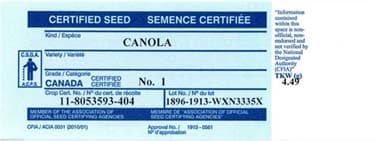
With an average seeding rate of 5 lb./ac., an average thousand seed weight (TSW) of 5 grams, and 50% seed survival rate, the result is only 5.2 plants per square foot. This doesn’t leave much margin for error — especially given the ideal target is 7 to 10 plants per square foot.
Seed with a lighter TSW can improve your plant counts, but agronomy measures to improve seed survival can also make a big difference. Here are ways to increase seed survival and get more from a seed investment:
Seed shallow. Half an inch to 3/4” below the packer furrow is the recommended seed depth for canola. Being consistently at this depth will reduce days to emergence and give the seedling more vigour when it emerges.
Seed at a consistent depth. The more consistent the better. For some drills, the overall average may be one inch, but the range could be 0”-2”. Too shallow or too deep can both contribute to seed and seedling mortality, and those that do emerge will have highly variable emergence dates, creating an uneven field.
Seed slower to ensure good and even seed depth from all openers. The ideal speed will vary by drill and soil conditions. In general, at higher speeds, rear openers tend to throw more soil over the front rows. Seed in these front rows will be buried deeper, making them slower to emerge — if they emerge at all. Re-check depth when moving from one field to the next.
Limit seed-placed fertilizer. Nitrogen fertilizer placed in the seed row can increase seedling loss to due toxicity and salt effect. Safe rates of seed-placed nitrogen range from 0 to 50 lb./ac. (over and above N in P fertilizer) depending on soil type, soil moisture conditions and seed-bed utilization. The best practice is to place only phosphate fertilizer with the seed at rates up to 30-40 pounds of phosphate per acre, and then put the rest of the N and other nutrients away from the seed row. The more fertilizer put down at seeding, the farther away it should be from the seed row.
Penetrate trash. Spread residue evenly in the fall, and have a drill that can penetrate trash so all openers place seed into the soil.
Leave a firm seedbed. Openers that fracture the seedbed to place fertilizer lower than the seed may not provide the firm moist seedbed that canola needs. Worn openers that do not provide a defined seed ledge and high fan speeds that cause seed bounce can also reduce an opener’s ability to place seed precisely.
Pack appropriately. In wet conditions, reduce packing pressure to limit hard crusting. In dry conditions, pack more to conserve moisture in the seed row. Packing pressure can be a delicate balance, and often changes by soil type as well as moisture conditions.
Rotate crops. A tight canola rotation will increase the risk from seed and seedling diseases that can prevent emergence.
Seed into warmer soils. This can greatly increase survival, and by late May soils are usually fairly warm or will be soon.
